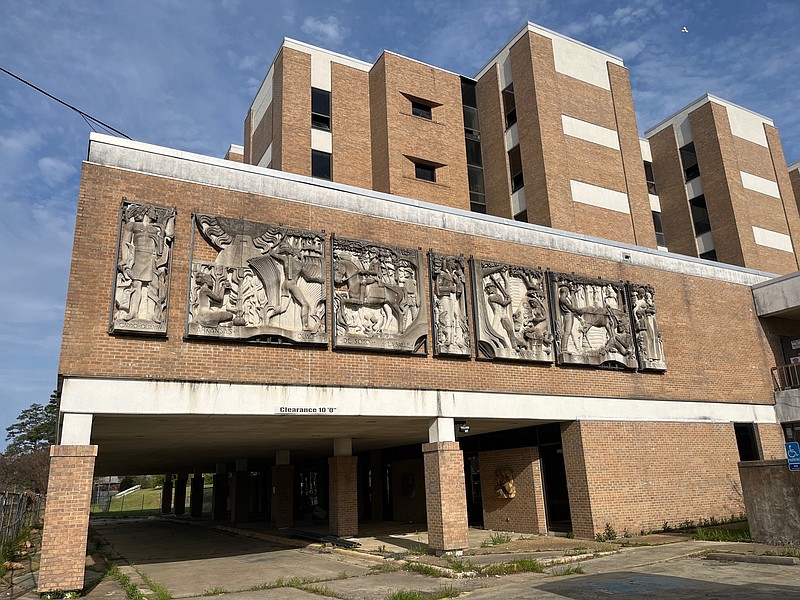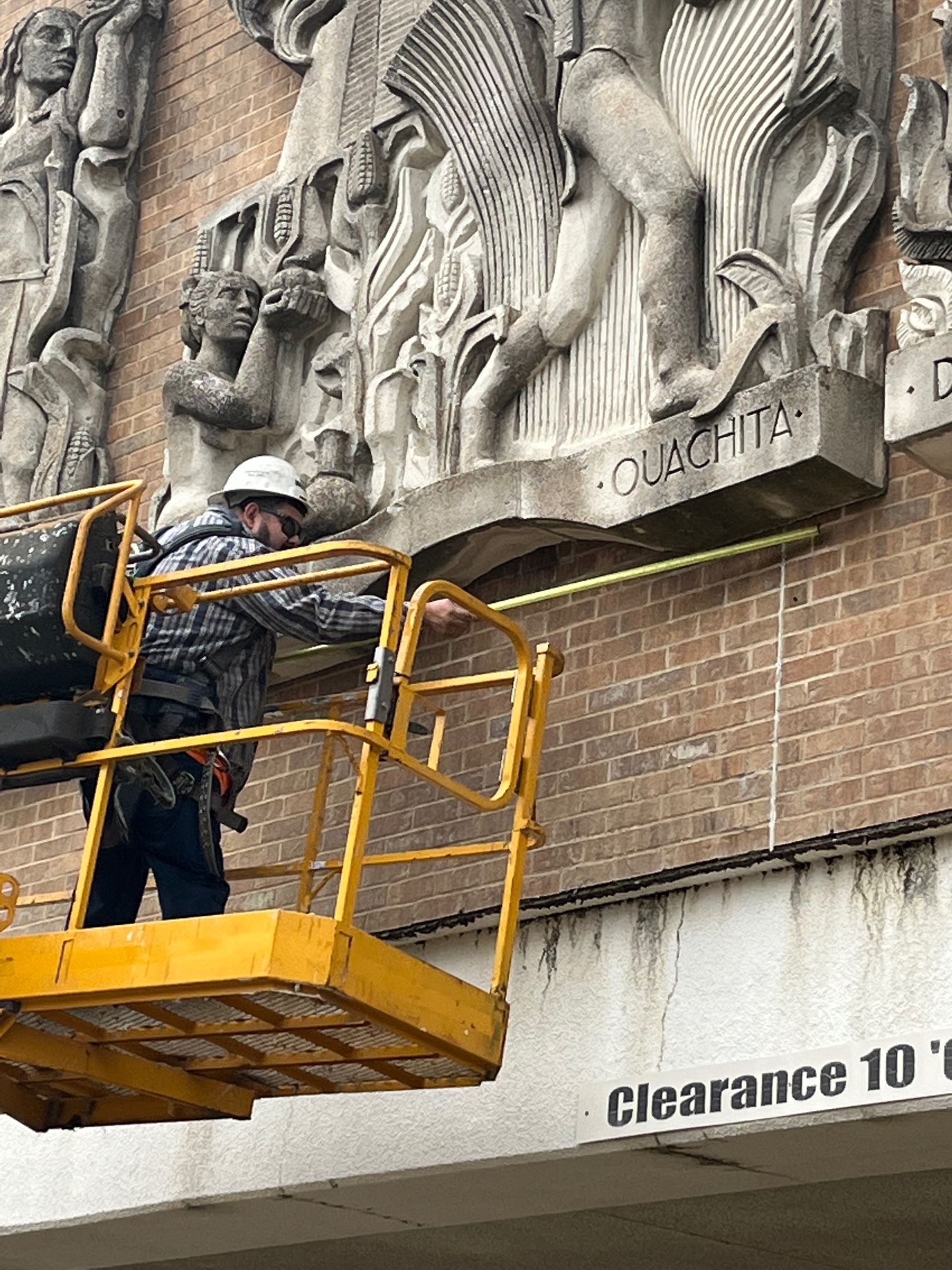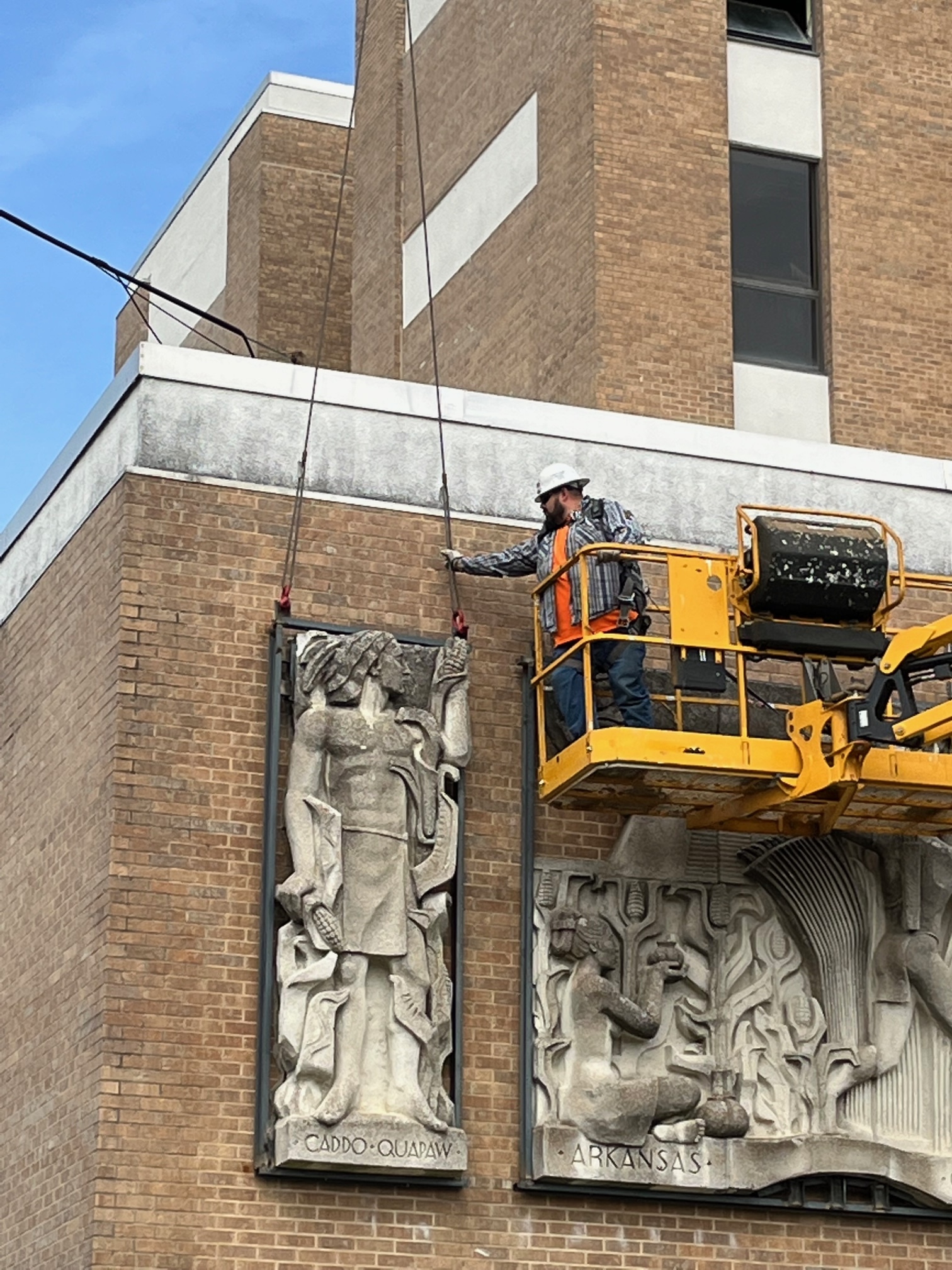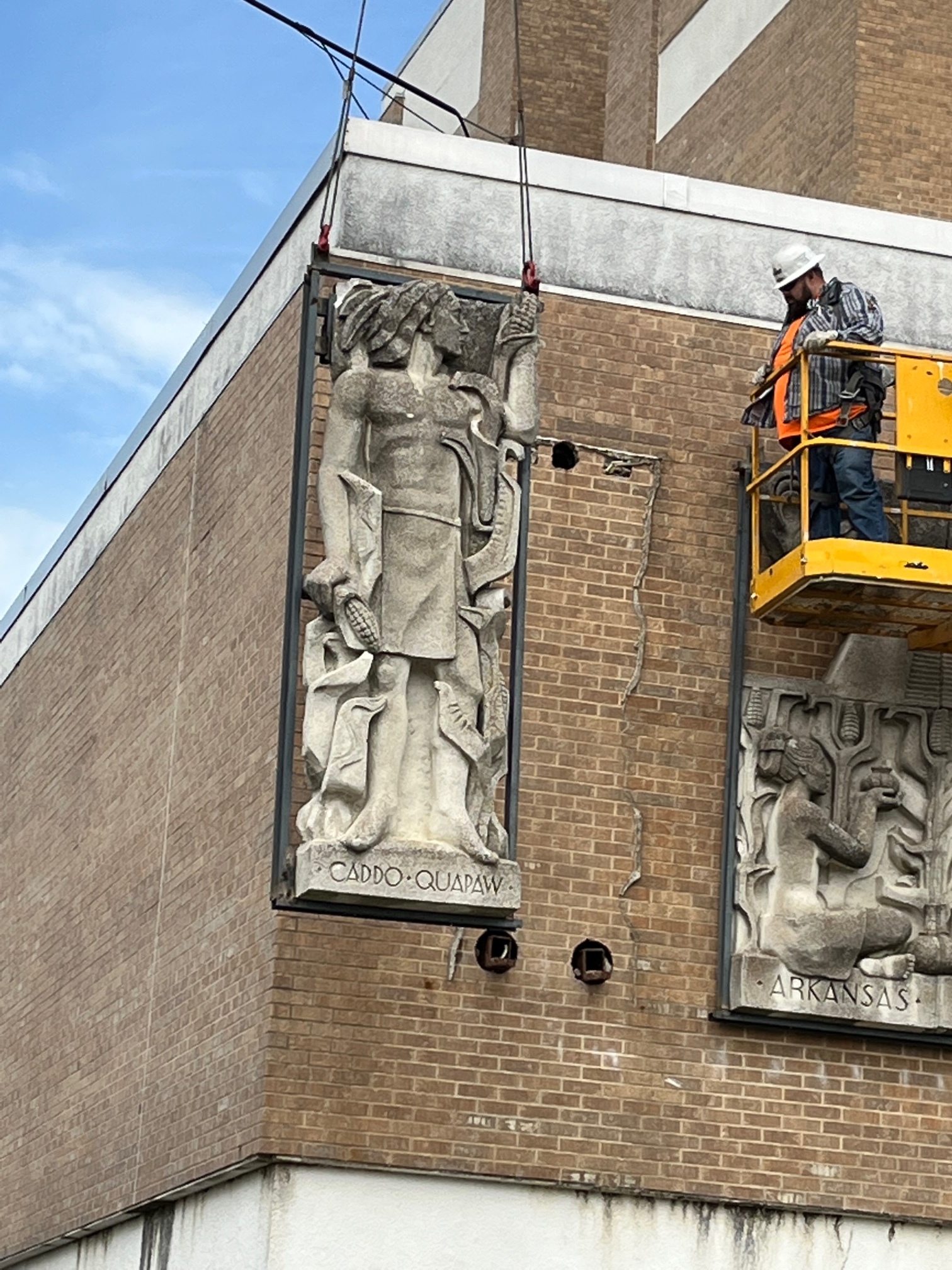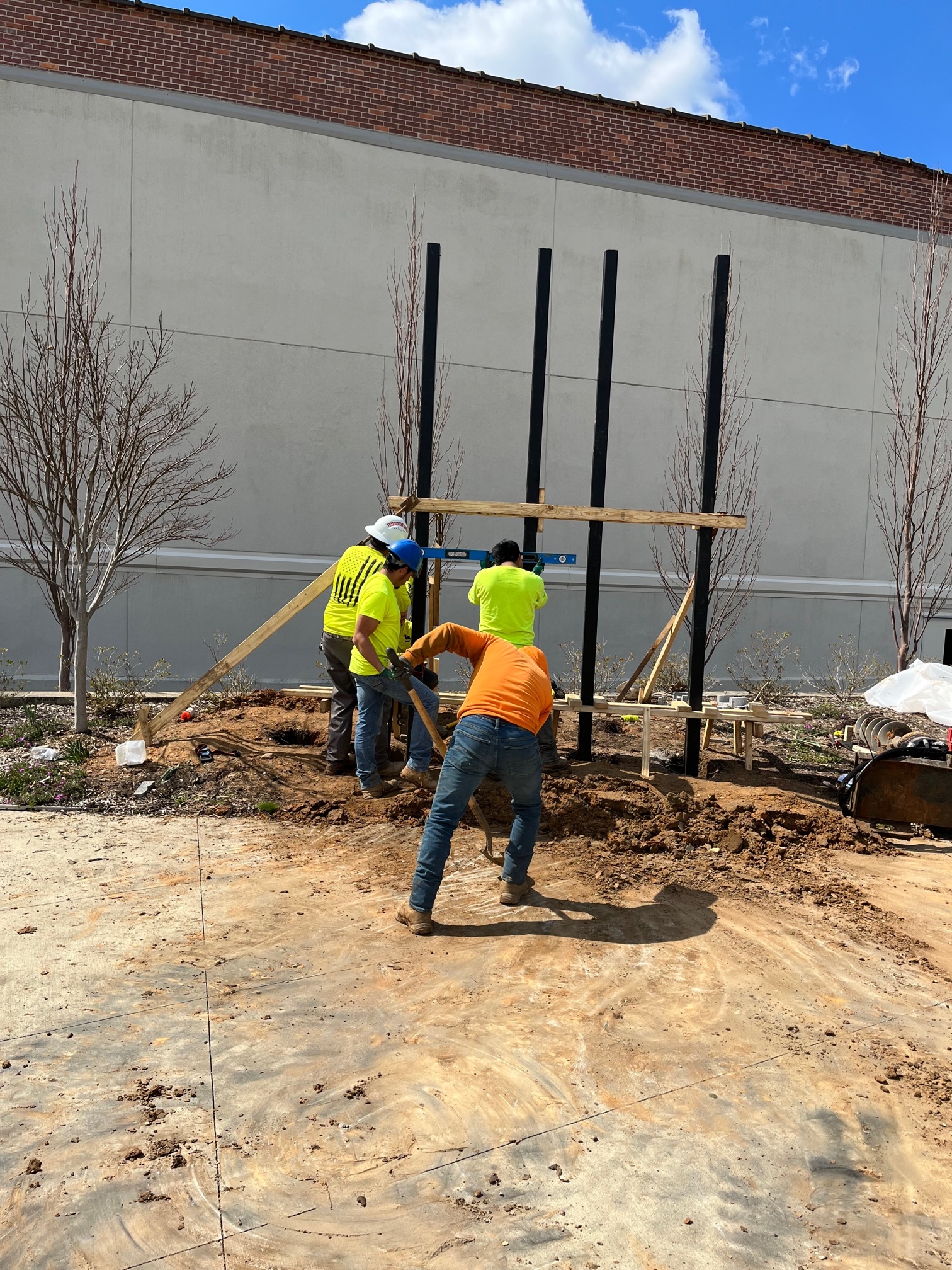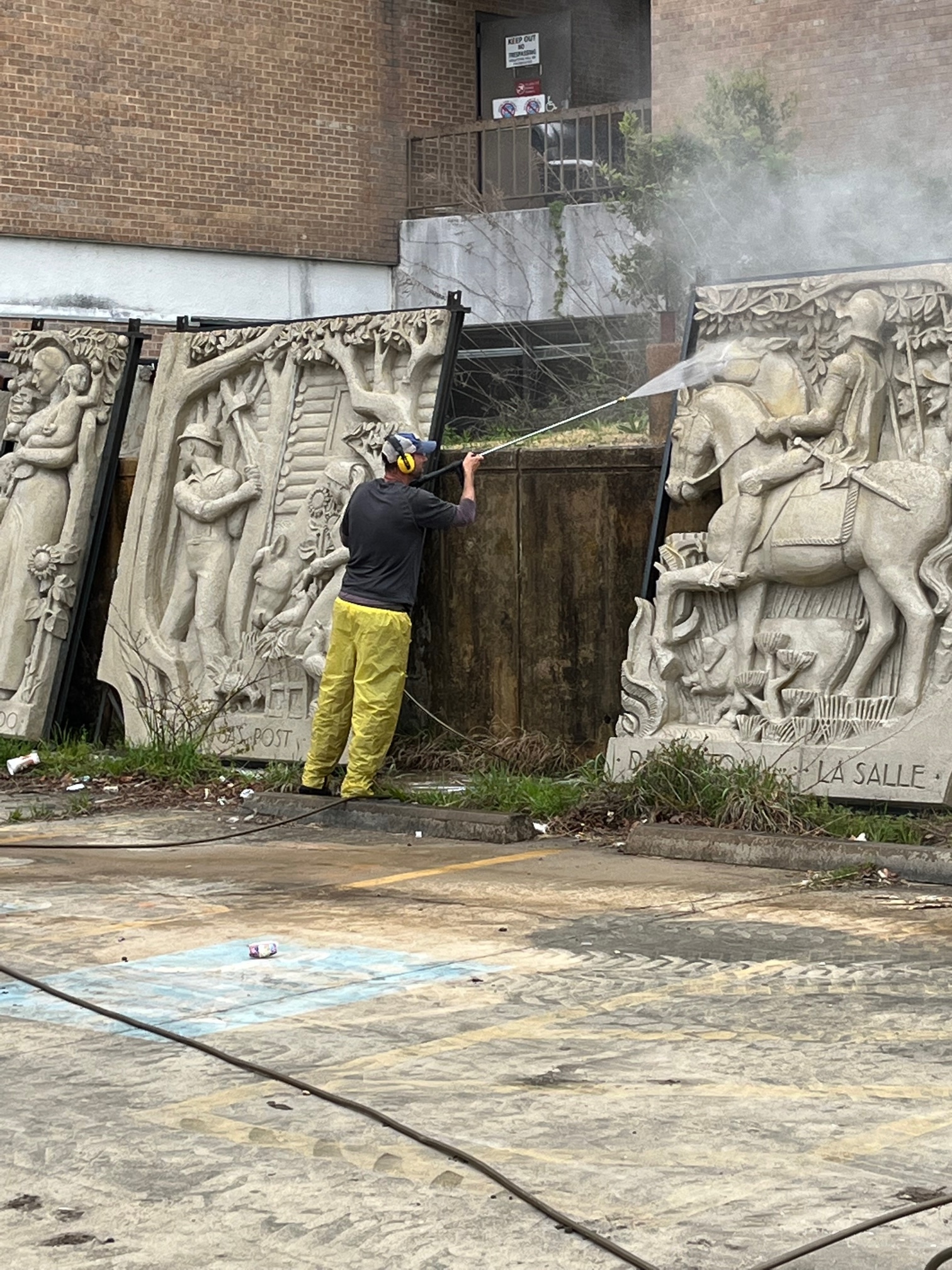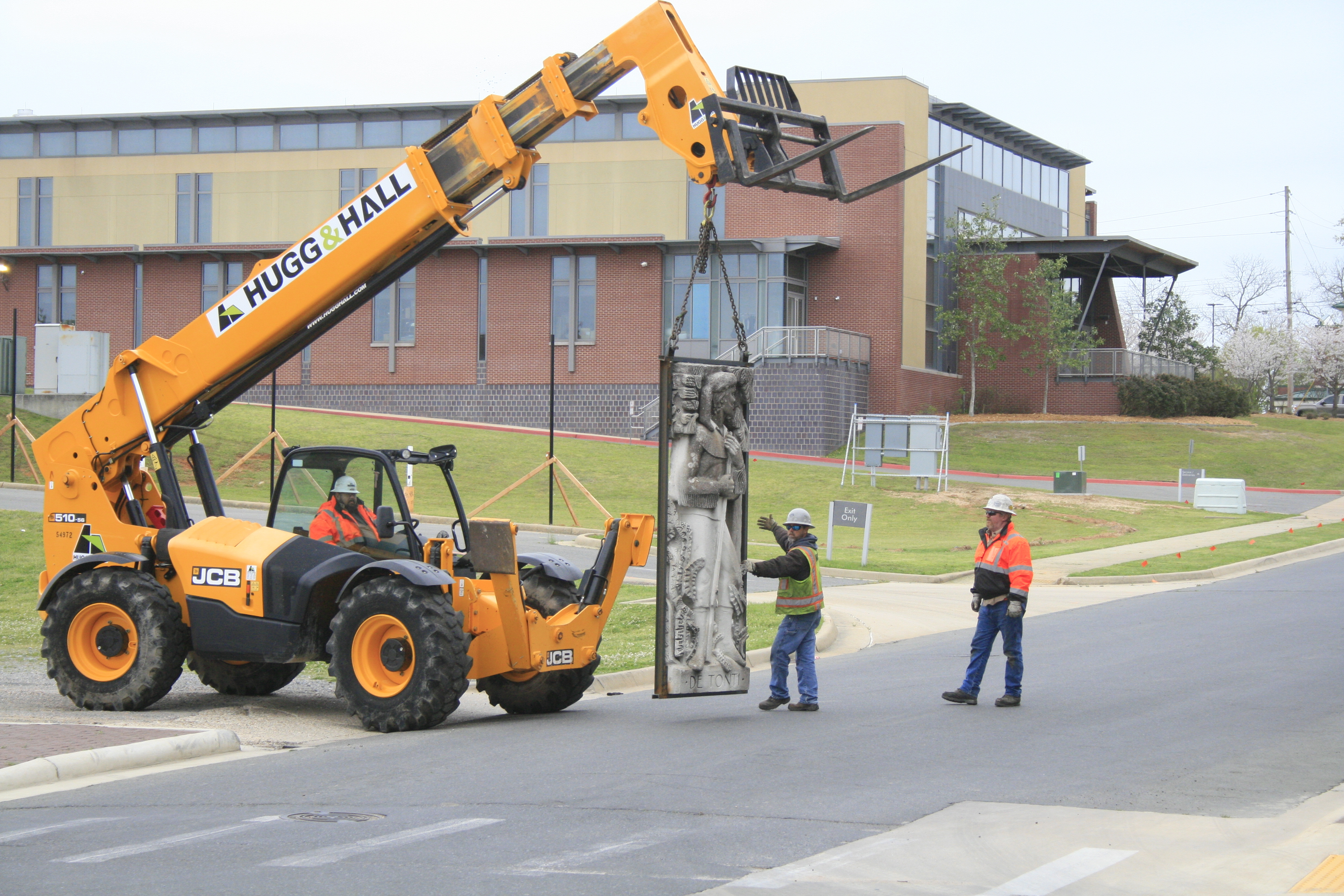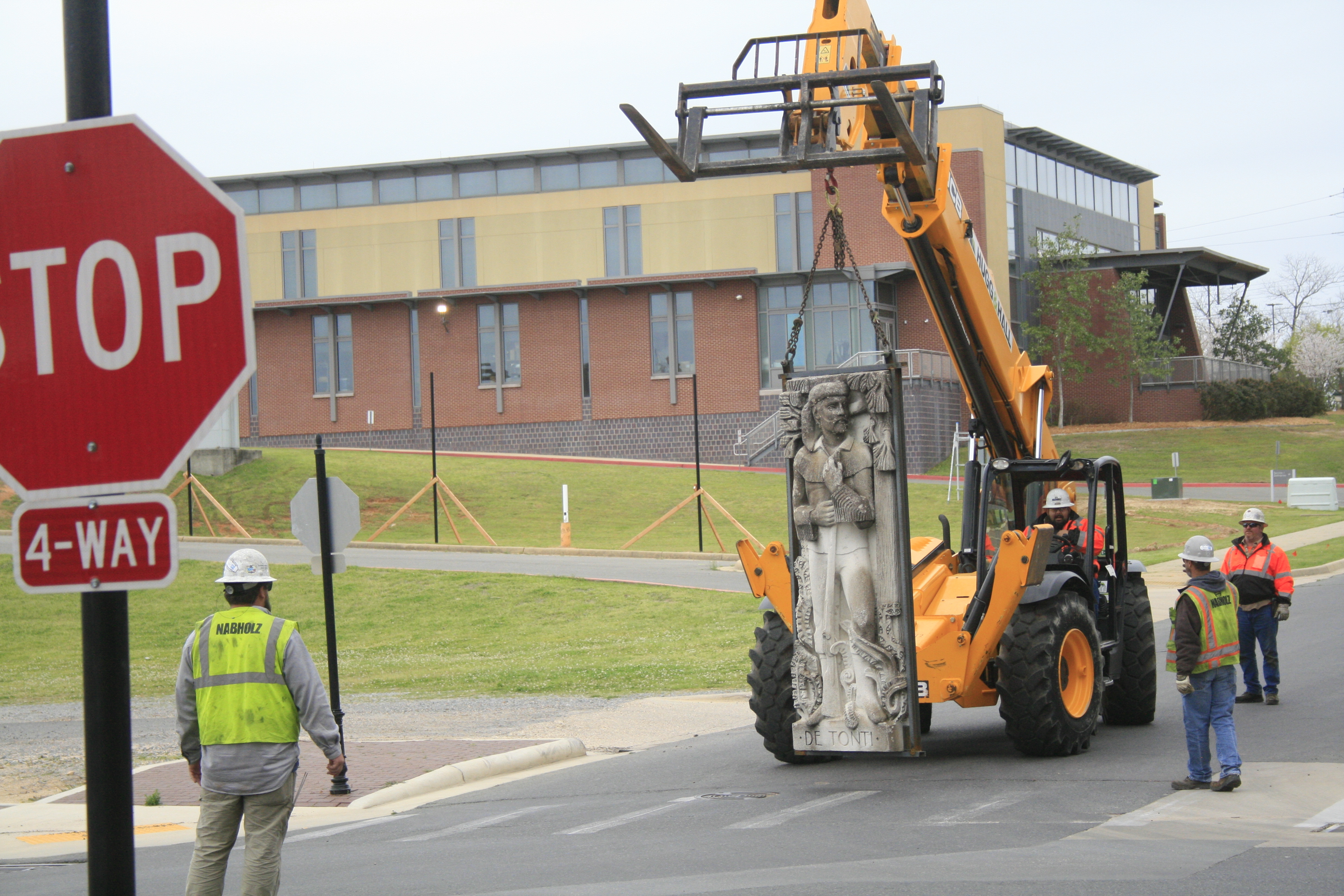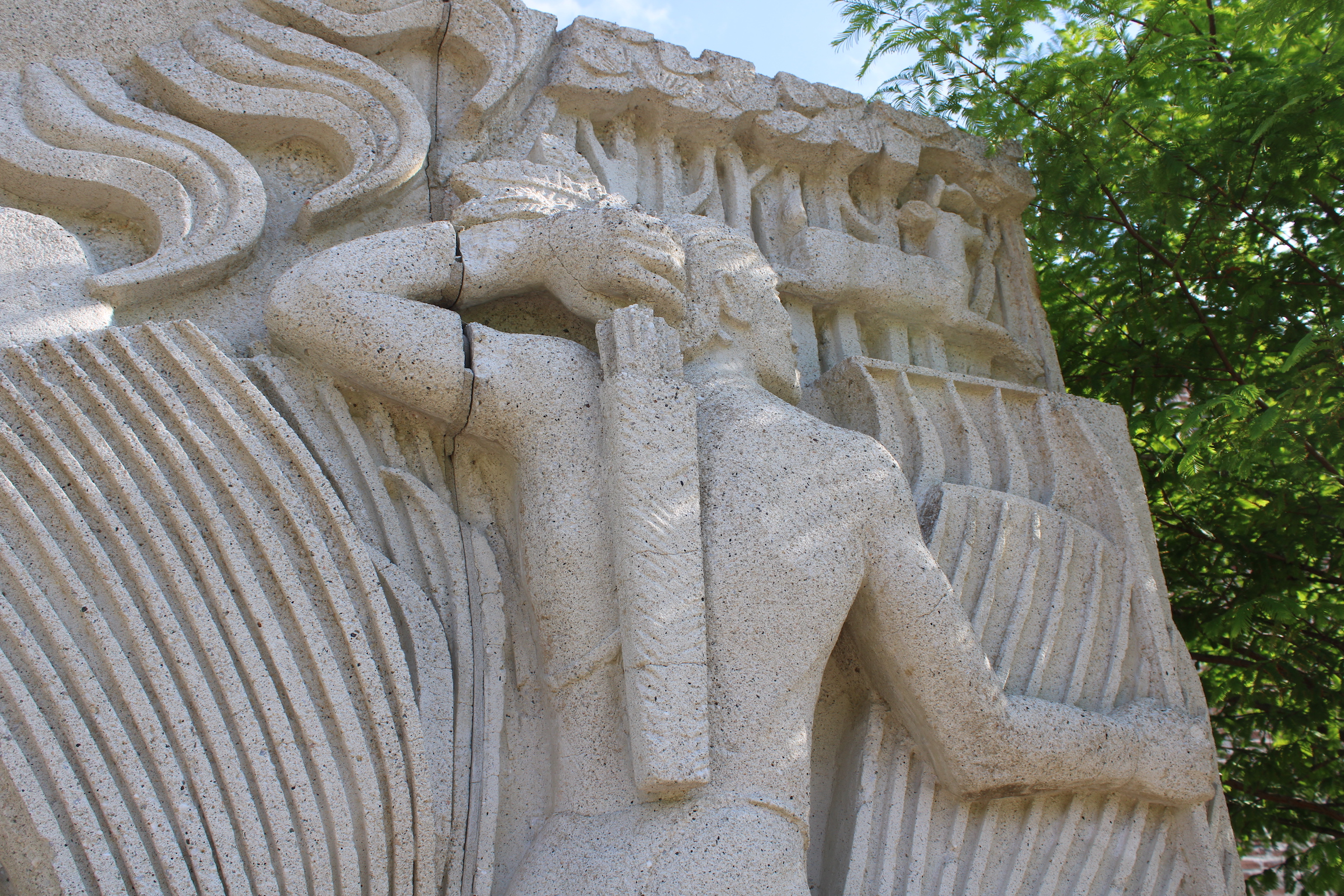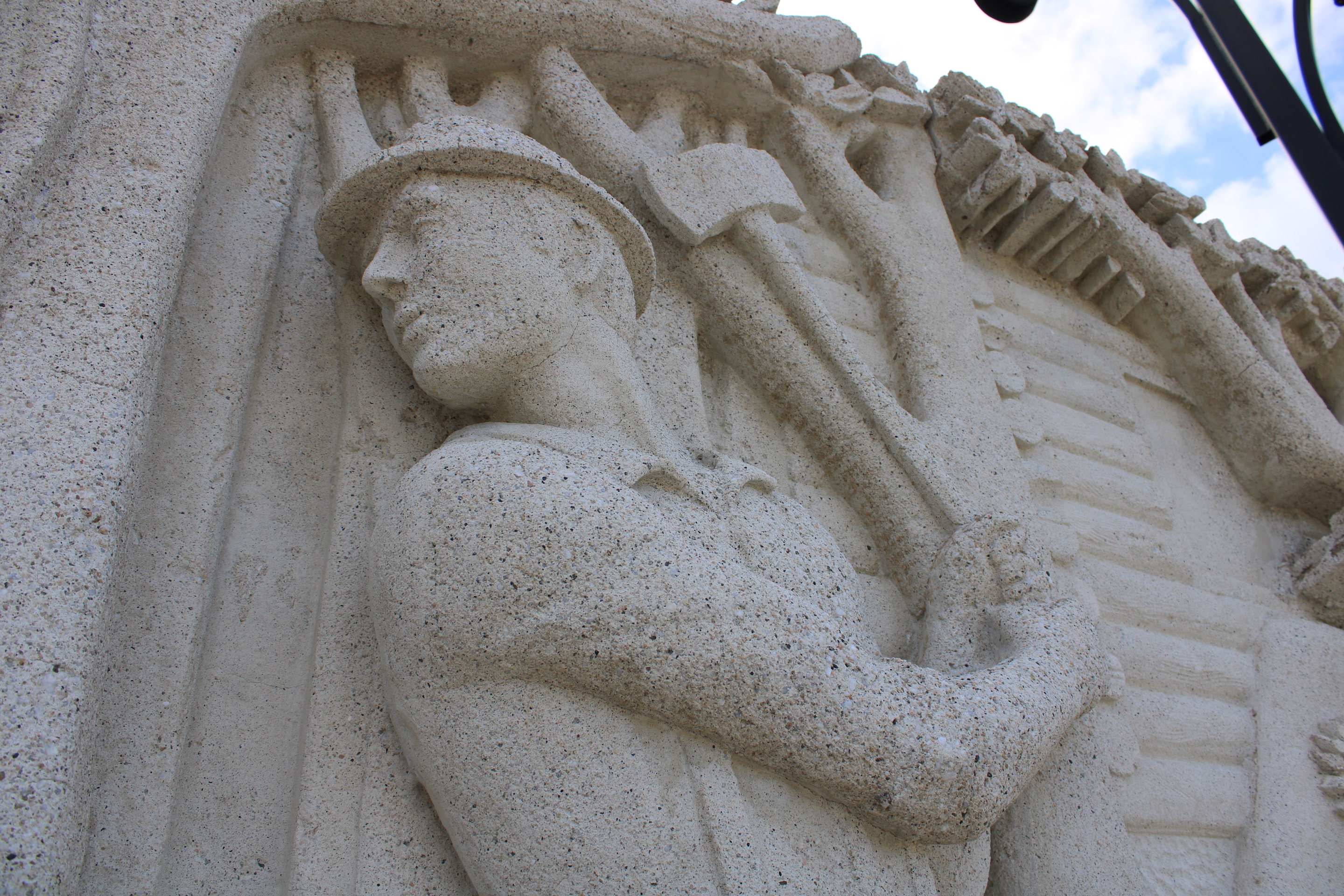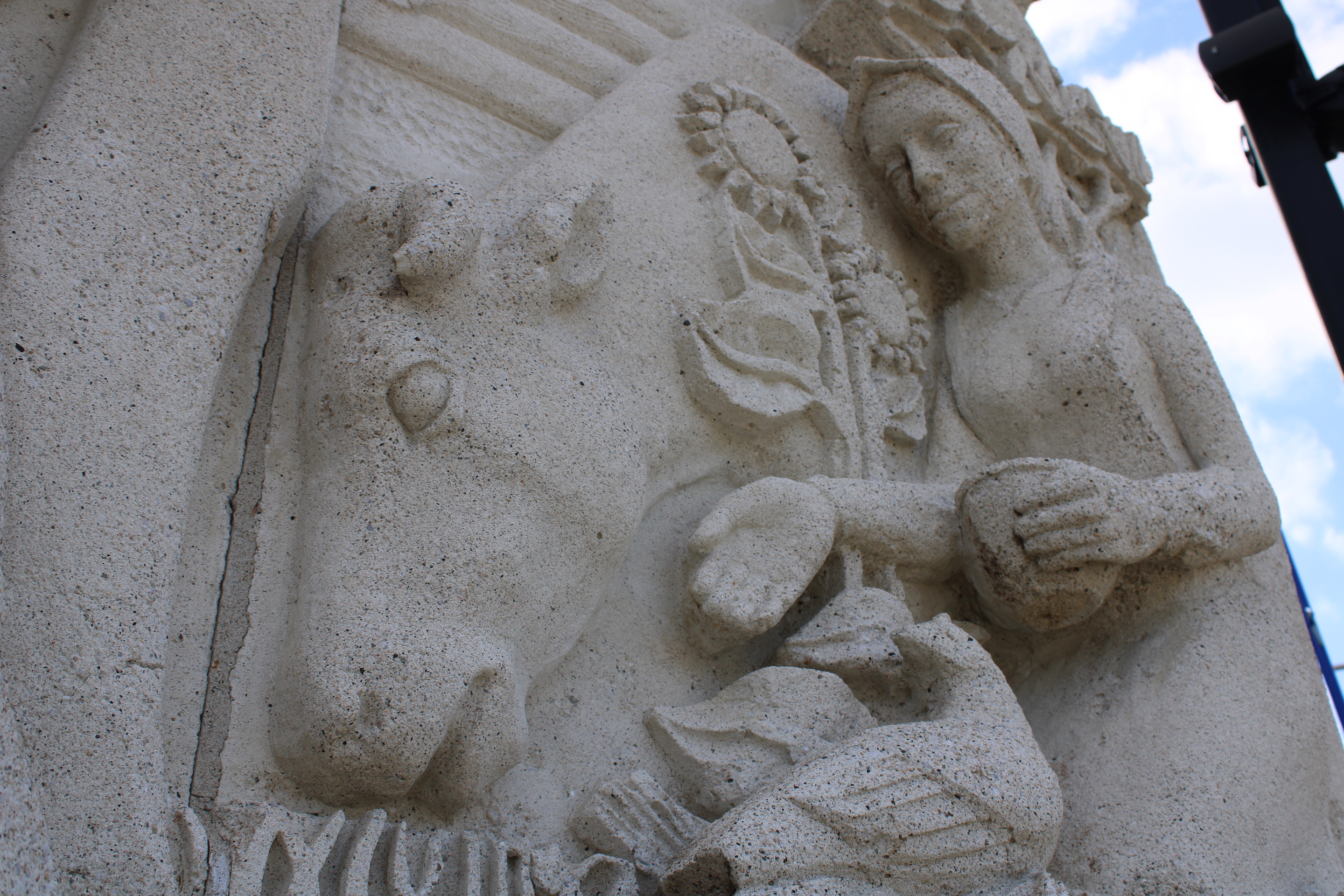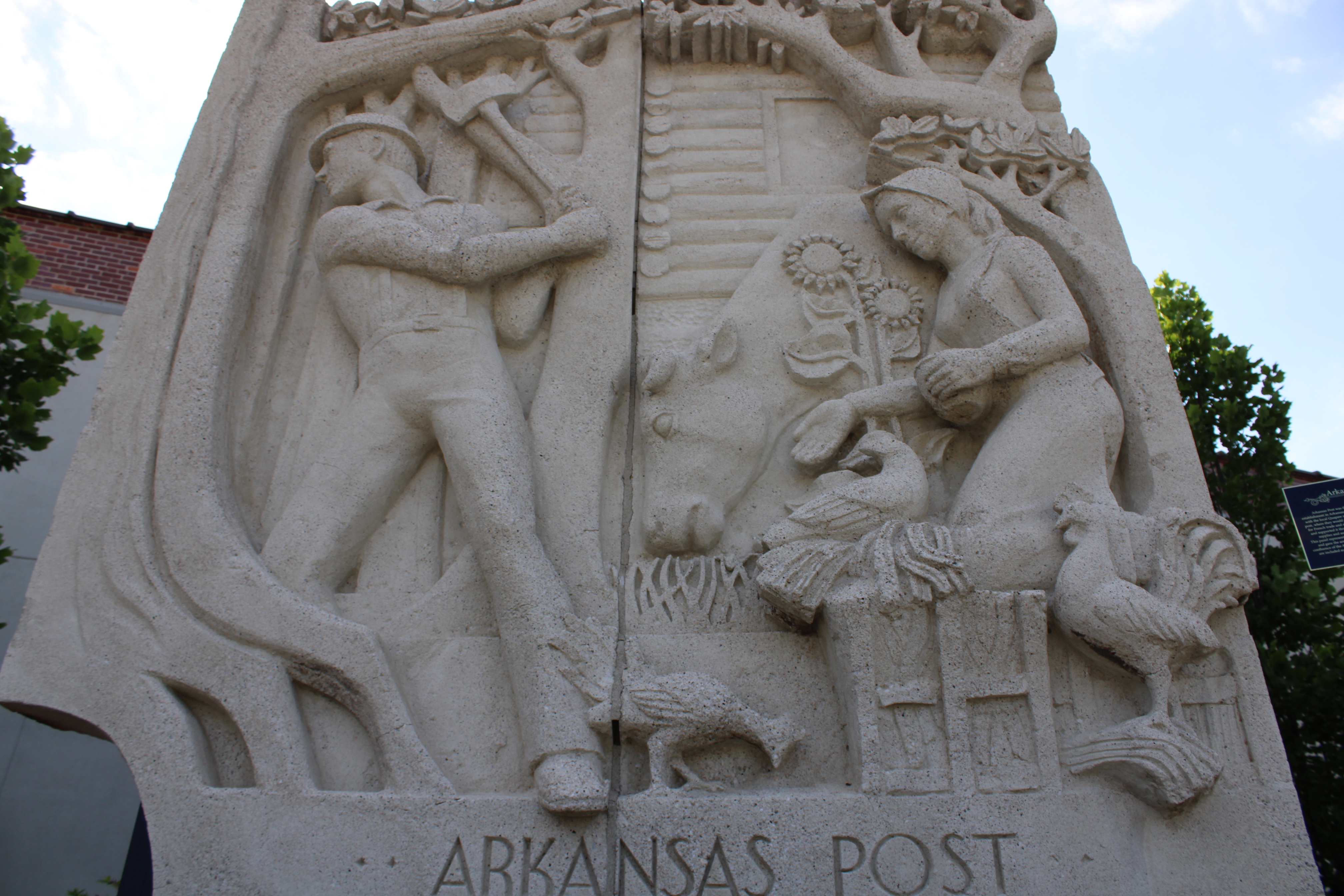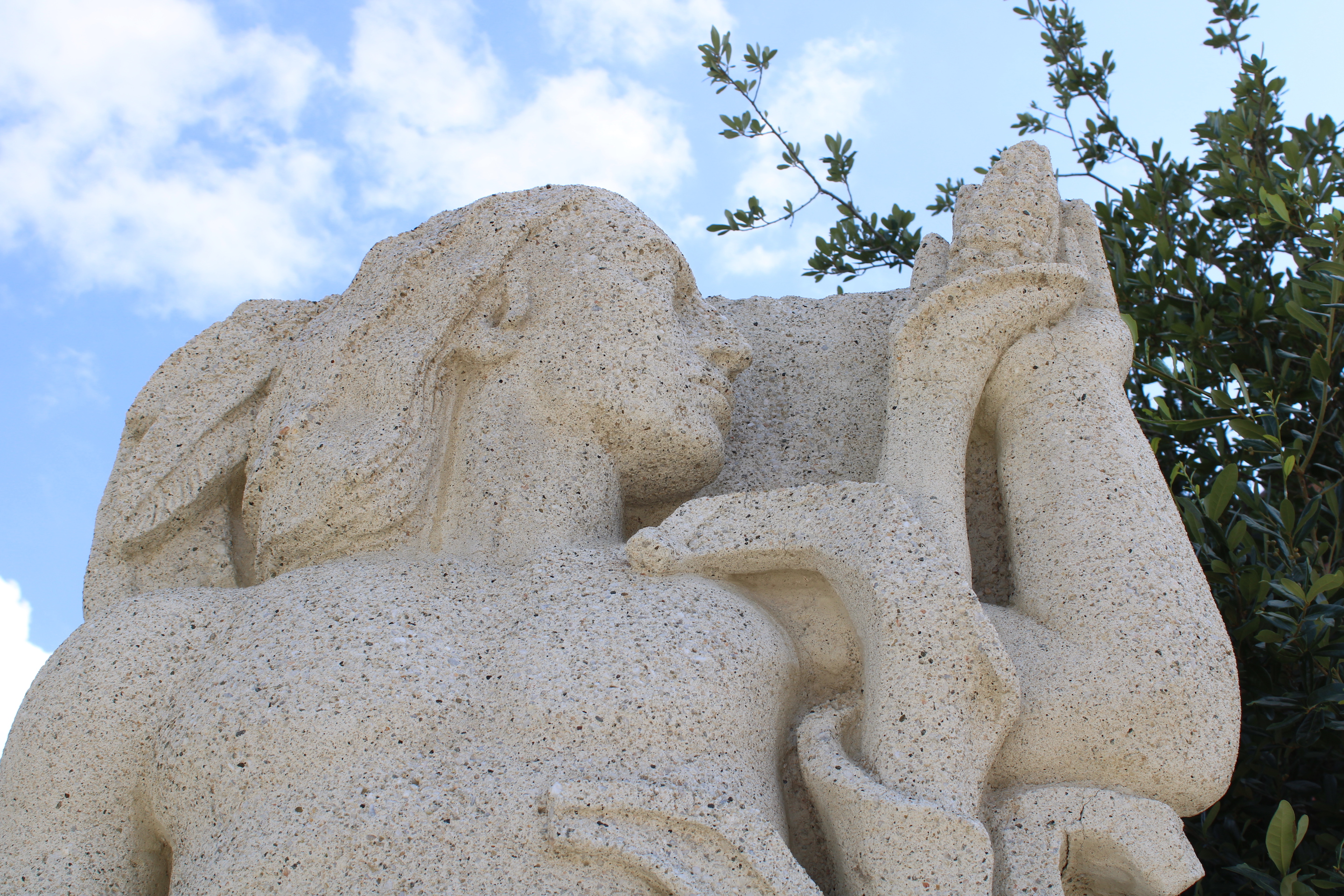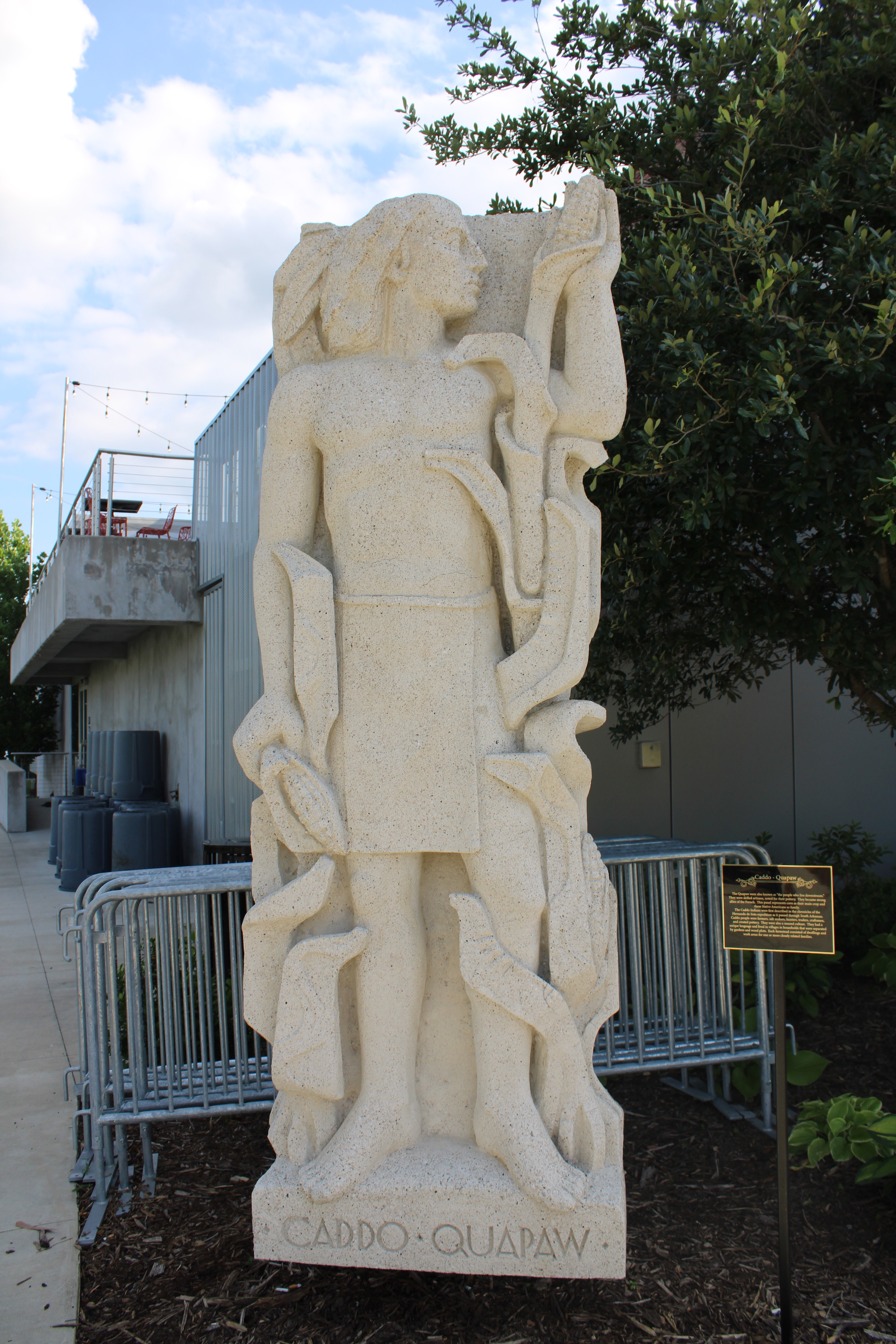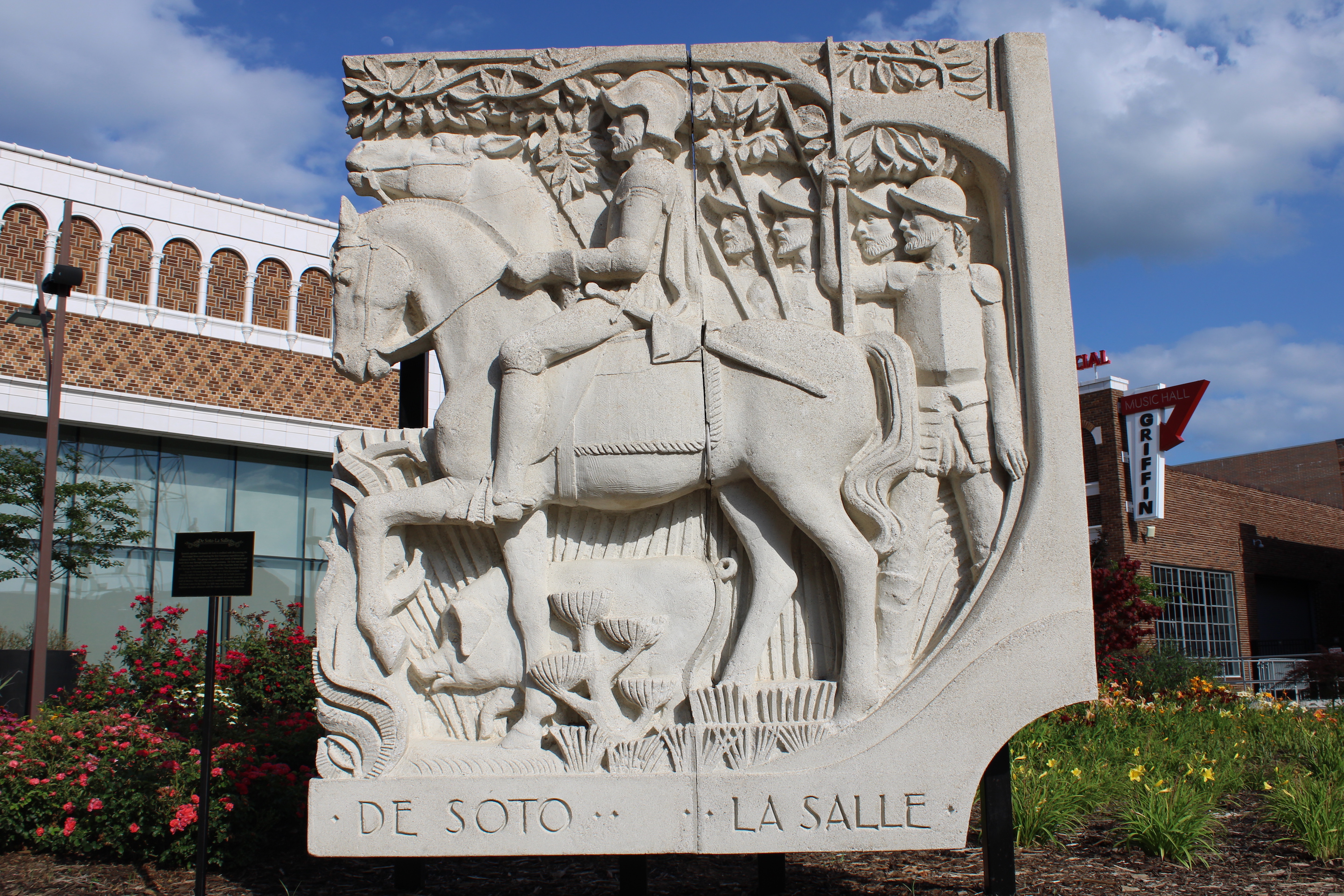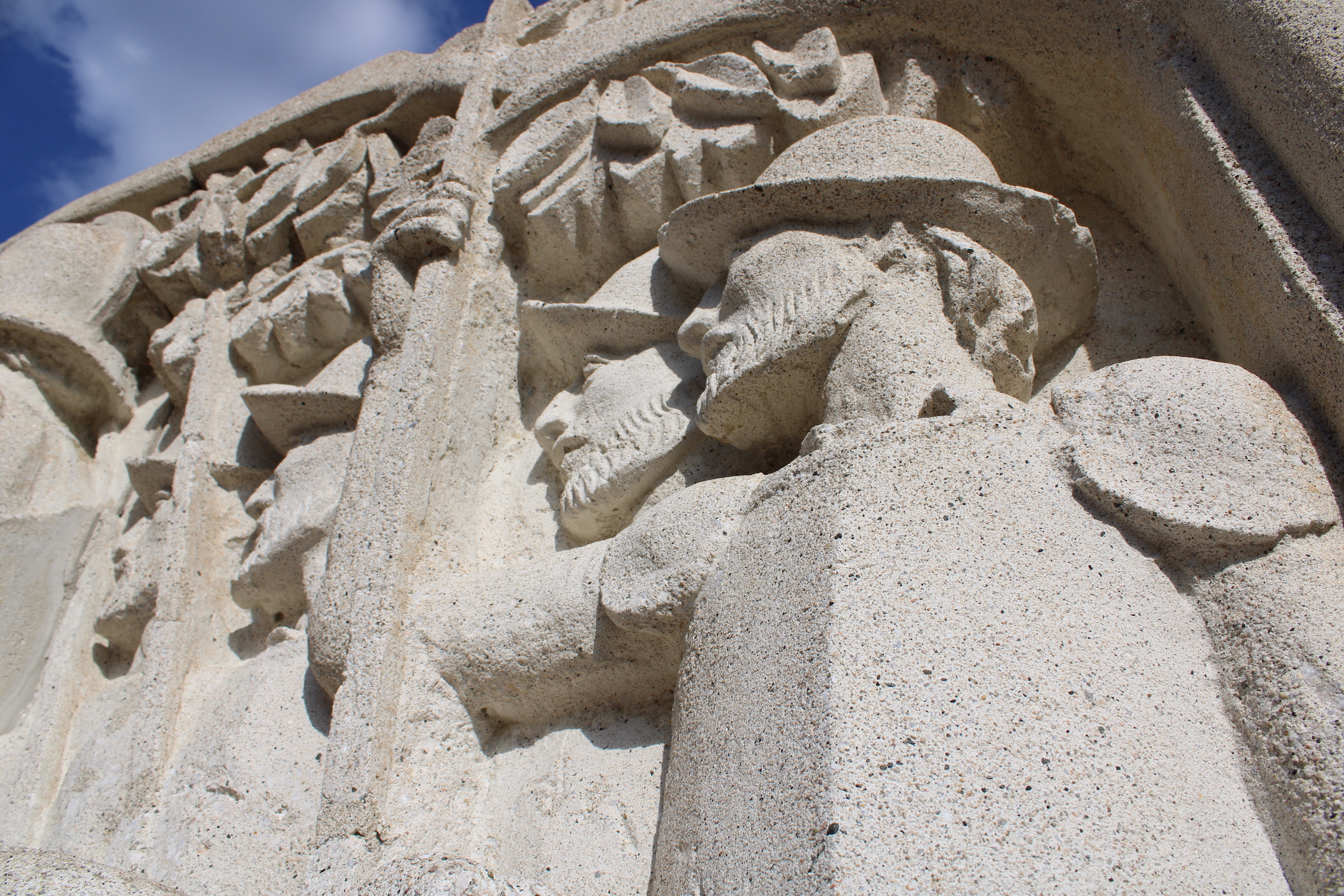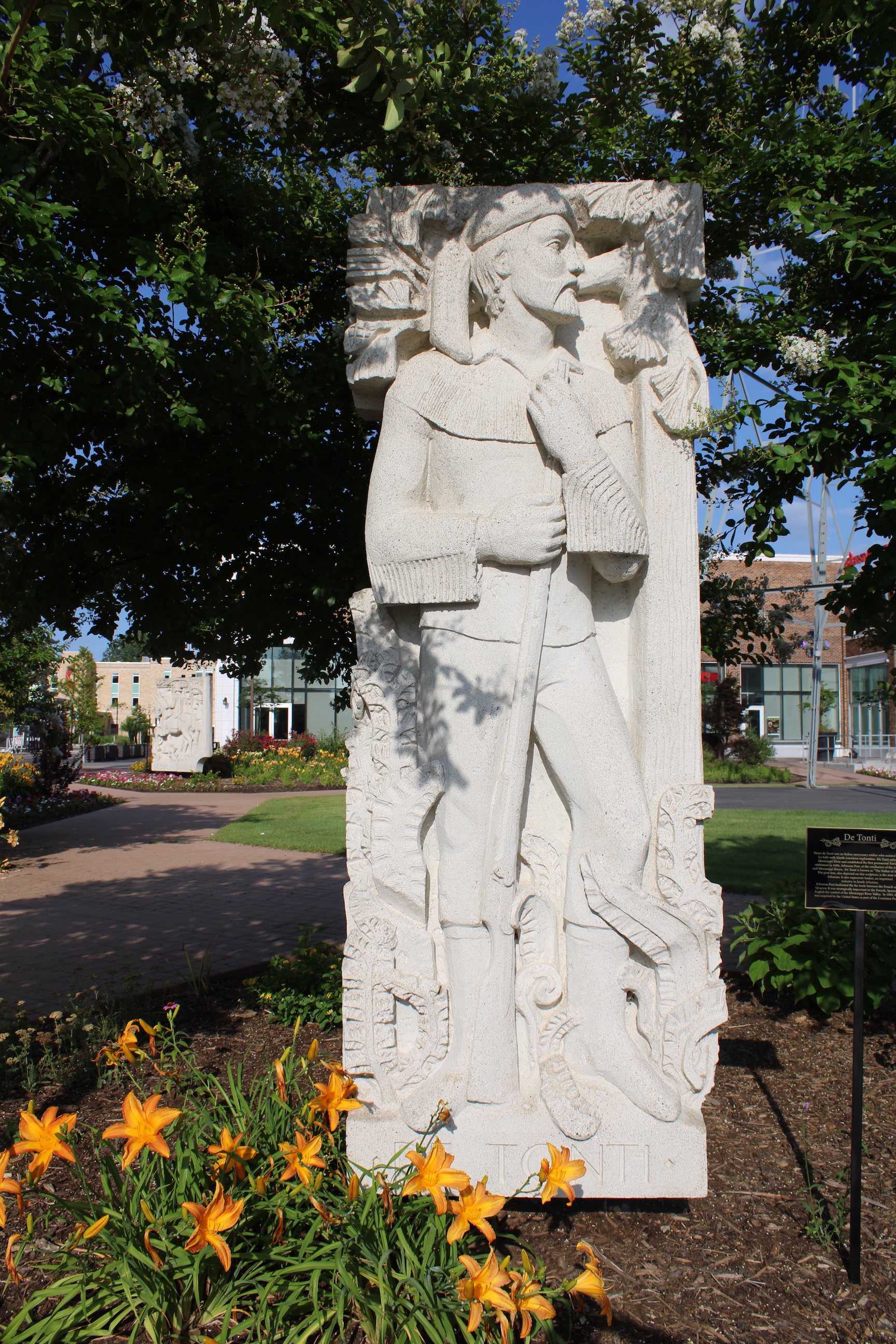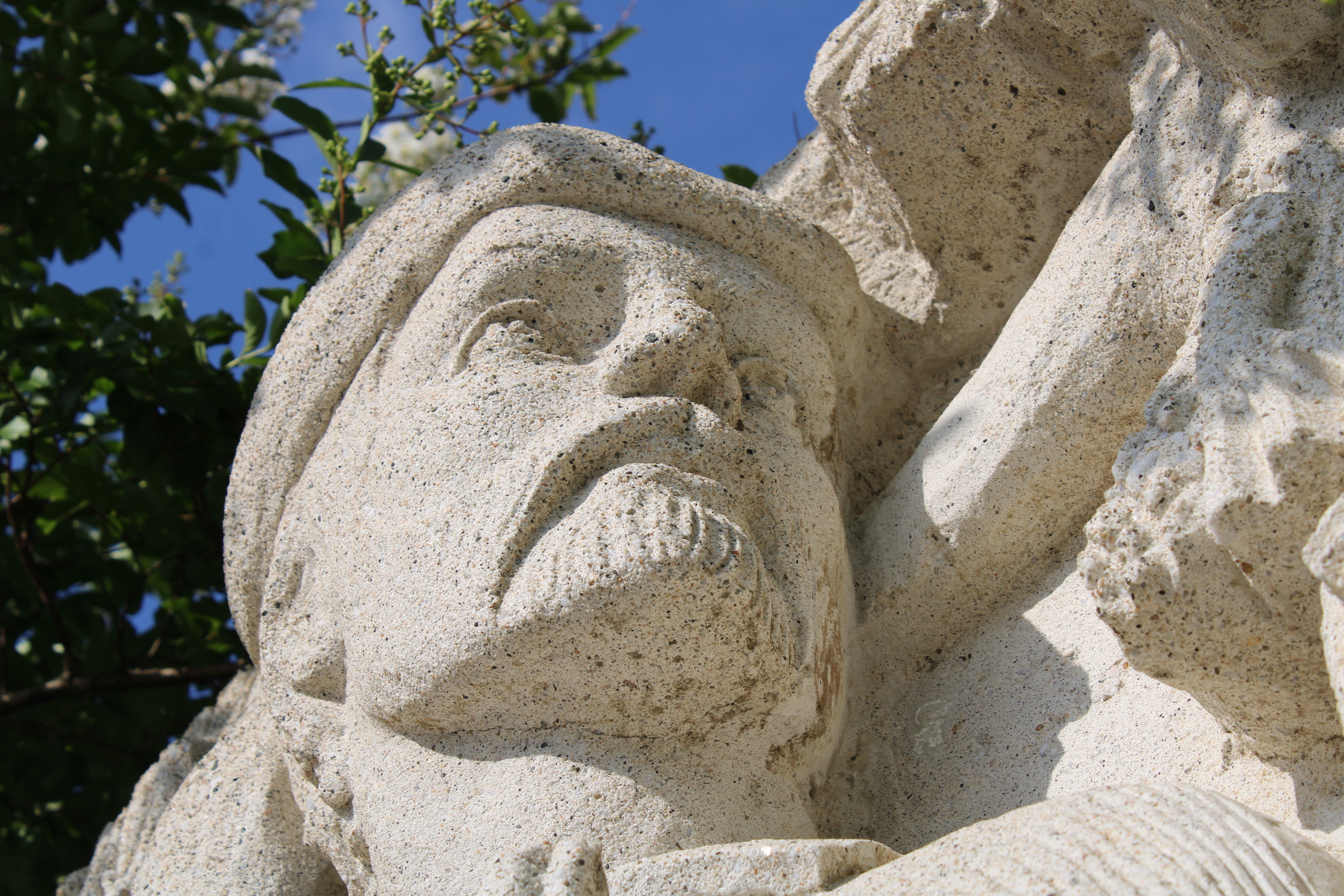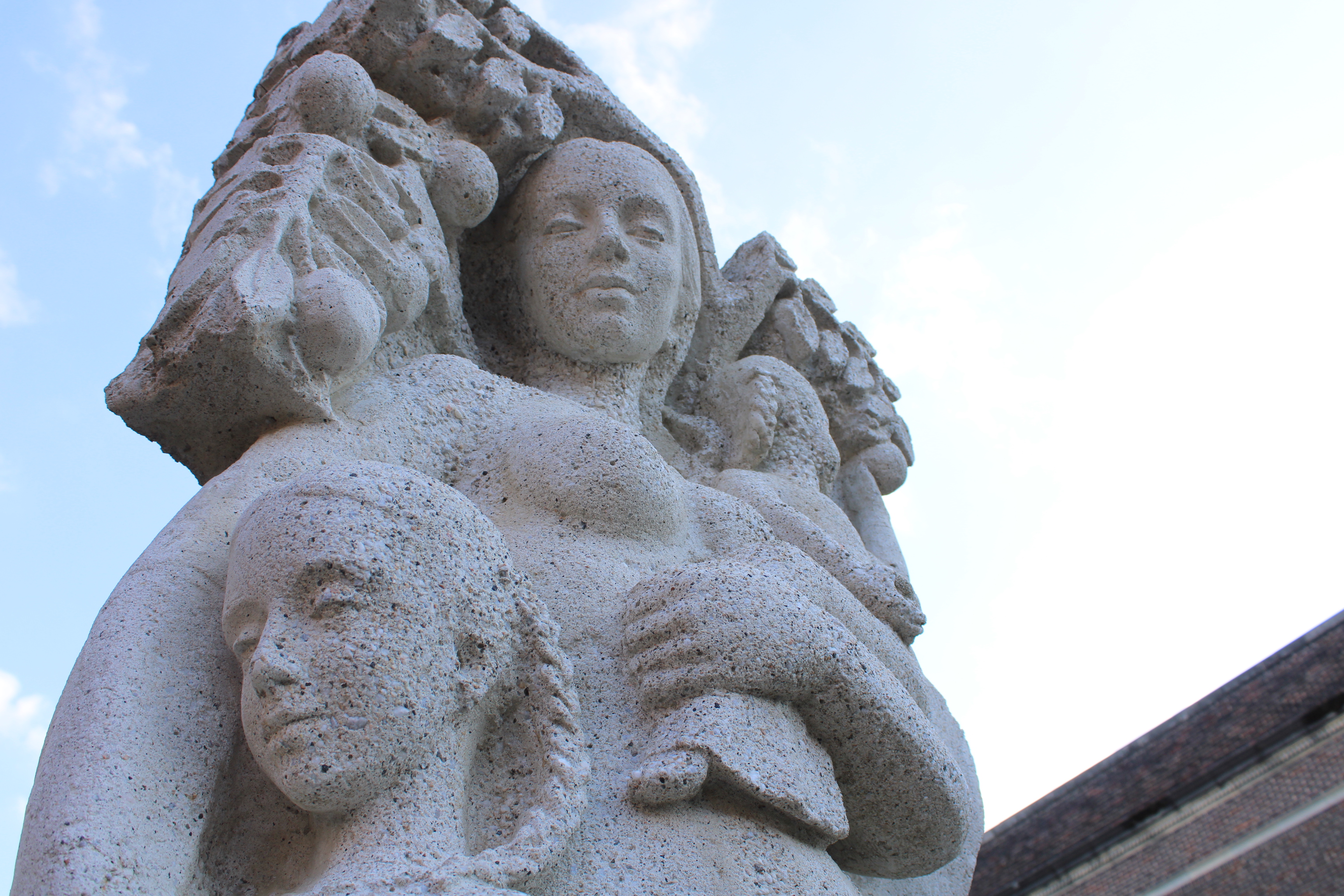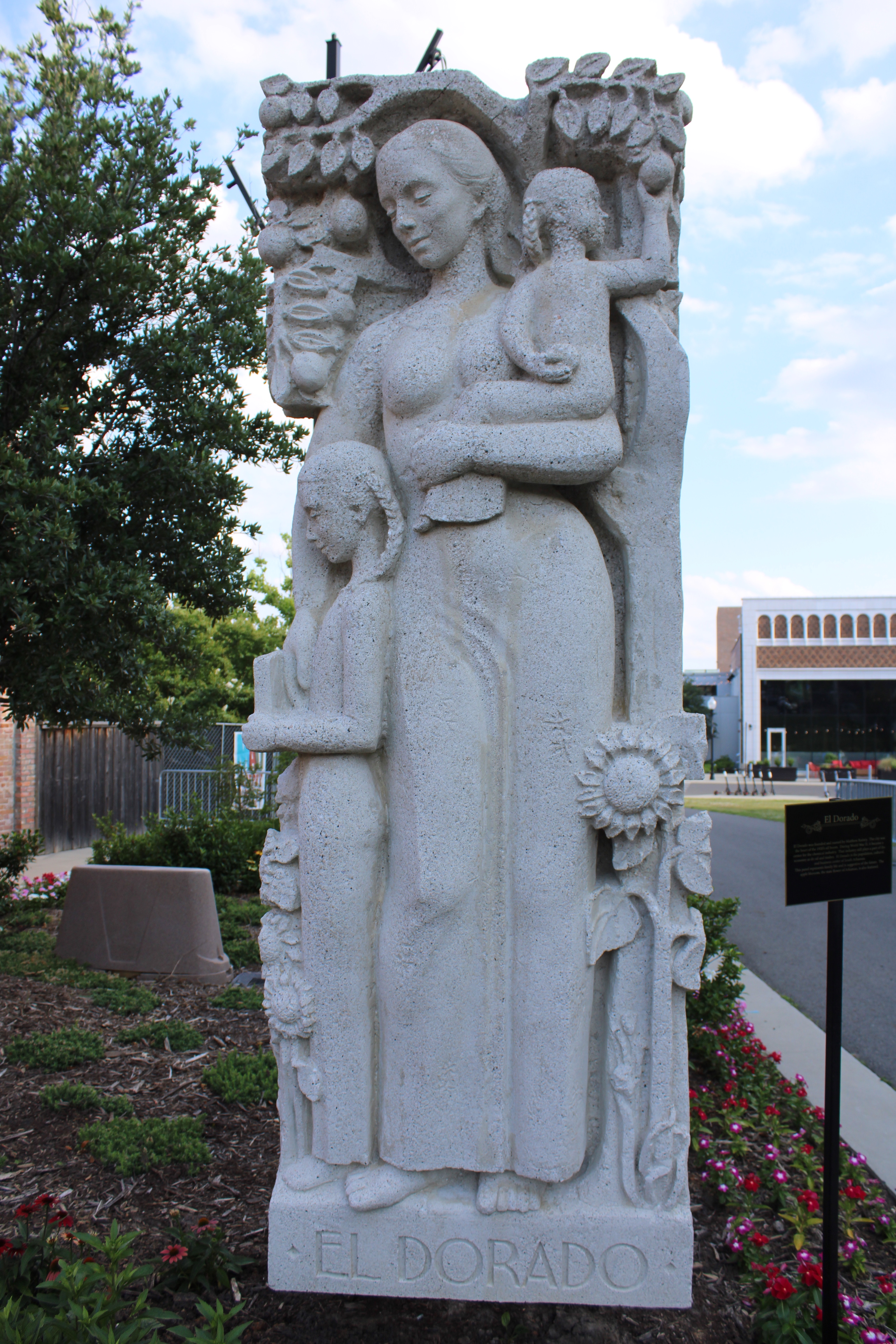A work of art takes on its second life when it leaves its creator's studio.
Its first life – its actual creation, from concept to execution -- lives in the mind of the artist; but once the work is handed over for public consumption, it's reborn, defined then by what every individual takes away from it.
In the case of what was once a high relief frieze adorning an outer wall at Warner Brown hospital, the seven concrete sculptures that comprise the work have taken on a third life.
Six of the seven sculptures are helping the Murphy Arts District live up to its name as they dot the landscape at the entertainment complex downtown.
"Our name is Murphy Arts District, so people expect to see art, so we're happy that we're getting to display art that is outside and the public can easily have access to it," said Joanna Benson, MAD marketing coordinator, in April. "And something that's permanently here is amazing."
'Purpose and traditions'
Dr. Paul Henley wasn't originally from El Dorado, but he left a mark on the city that he made his home.
From serving as President of the El Dorado School Board and the El Dorado Wildcats' team doctor to asking famed architect Fay Jones to build him and his brother-in-law homes in town and chairing the South Arkansas Symphony board, Henley was dedicated to the community, and particularly, the community's health.
A World War II veteran and surgeon, Henley worked at Warner Brown hospital, including as its chief of staff, through the mid-century period. The idea to incorporate art into the healing process for hospital patients was his, "born out of the conviction that a hospital should be more than a drab, colorless building where people simply come to live or die," according to comments made by Warner Brown board chair Russell Marks in 1982.
At Henley's urging, the Warner Brown Board of Directors allowed an Artistic Development Board to be formed in the mid-1970's, and Lyda Merkle was selected to chair the committee. Herself an artist, Merkle played a role not only in Warner Brown's artistic history, but also that of the South Arkansas Arts Center, which she helped found.
"A hospital should have a character that expresses hope and joy and beauty, all attributes that will indirectly lead its patients and their families towards health and life," Marks said during a dedication ceremony for the frieze.
Merkle, at the same dedication, highlighted a statement Henley made in 1980, when he said his mission in advocating for art at the hospital was "to create on these walls artworks that would most nearly typify the purpose and traditions of this hospital."
The committee decided on a theme for works to be commissioned for the hospital: "our beloved State of Arkansas with its abundant wildlife, natural resources, history and people." From there, Merkle wrote to Millard Sheets, a nationally-known painter, mosaicist and arts educator, asking him to help develop a master plan for the hospital's artistic evolution.
Sheets agreed, and working with artists he knew and some local to the region, curated a collection of art – some commissioned and created specifically for the hospital – to enhance and enrich Warner Brown. Works included everything from the sculpted frieze to ceramic tile mosaics to lithograph prints to oil paintings.
It was a cold, overcast day in April, 1980 when the first works created for Warner Brown were celebrated. Two years later, on a clear Sunday in March, 1982, the frieze was similarly dedicated.
Work in progress
Originally, Merkle's idea was to ask Sheets – who was famous for mosaic murals, including one that adorns Los Angeles City Hall, which itself is reminiscent of El Dorado's own, designed in the same art deco style – to design a piece of art that could be displayed on the outer walls of Warner Brown, said Gay Bechtelheimer, an El Dorado-based artist and arts educator who has been instrumental in the six sculptures' move from the hospital to MAD.
"Millard Sheets... he was an artist, he was an educator – very influential in artistic circles in the United States. They contacted him, and he had done a lot of murals, mosaic murals – first, they thought that's what they wanted to do," Bechtelheimer explained. "But his son is Tony Sheets, and (he and sculptor Richard H. Ellis) were doing these sculptural panels throughout the Southwest, the West and the Southwest, on buildings, so they were recommended to do this and that's where they decided they would do this frieze, this sculptural frieze that would go on the building."
Both sculptors, Ellis and Tony Sheets were selected to create a work of art that would tell the story of south Arkansas' history. They started by researching what was known at the time about Arkansas' founding and early days.
From there, they sketched out their idea for each of the seven, concrete relief sculptures.
"The process was through sketches that we would work on together, independently, and back and forth until ideas came together to some kind of amalgamation or contribution," Ellis told those who attended the frieze's 1982 dedication.
The Board of Directors at Warner Brown approved the sketches, and Ellis and Tony Sheets began working on full-scale models of the sculptures. Made of Styrofoam and clay, the 9 foot-plus models allowed the pair to flesh out their designs even more.
Once they had the final designs molded in clay and foam, they made plastic molds of each individual sculpture, into which they eventually, apprehensively, poured the cast stone, "a fine grade of white cement with a particular aggregate and sand," Ellis explained.
"At that point, it was some tension, because as the mold is destroyed and whatever is inside is what we have left," Ellis said. "If the casting is bad, there is no going back; you have to start all over again."
After that was the hard part, Tony Sheets told dedication attendees.
"Following the casting of the sculpture, in California, we had to transport the sculptures down here," he said. "The combined sculptures are 13 individual panels put together into seven sections, as you will see on the wall. Each panel weighs approximately a ton and a half to two tons. This makes the whole thing quite heavy."
The pair "built quite an elaborate system to get it down here," Tony Sheets said, saving money on renting a second truck to transport the panels, which altogether weighed something close to 20 tons (40,000 pounds), ranged in width from 3 to 12 feet and all stood at 9 feet tall.
Once the artists arrived in Arkansas, work in tow, they set to displaying them, itself another monumental task.
"We devised a system to come inside the building with vertical steel beams which then are attached to steel projections through the wall, and most of you have driven by here the past month or two and seen all these holes and people thought you had termites," Tony Sheets joked at the dedication. "Each one of those holes represented a hanging bracket by which we will hang a panel on – or, several actually: four per panel."
'History of Arkansas'
The sculptures designed and cast by Ellis and Tony Sheets are narrative in nature. They represent a record of Arkansas' founding by European explorers; the Native Americans who resided here when those explorers arrived; the cultural interchange between the two groups; and the establishment of cultural and commercial centers in the state.
Displayed chronologically at Warner Brown, the frieze began with the panel labeled "Caddo-Quapaw," named for two Native American tribes known to be indigenous to south Arkansas. The panel shows their reliance on corn as a staple crop.
Next on the wall was the "Arkansas-Ouachita" panel, representing the first encounters between the native people of Arkansas and the European explorers who would go on to settle on the land.
"When the French explorers came, they encountered indigenous people; they had come from the North, and Indians in the Ohio River Valley had referred to the downstream people as the 'Arkansas' people. The French took that term and referred to the Quapaw Indians as the Arkansas Indians, so it's kind of their interpretation of the Ohio Valley Indians' term for 'People of the South Wind,'" Bechtelheimer explained in April. "And then the Caddo word 'Washita' meant 'good hunting ground.' And so French explorers spelled that 'Ouachita, O-U-A-C-H-I-T-A.'"
"The influence of this Caddo word continues to be found in the names throughout the natural state of Arkansas," Bechtelheimer said.
Following that on the wall was the panel dedicated to explorers Hernando de Soto and René-Robert Cavelier, Sieur La Salle. De Soto was the first European to cross the Mississippi River, and led the first expedition into the deep South of North America. He is also credited with introducing hogs into Arkansas. La Salle also traveled the Mississippi and is one of the first Europeans known to have made alliances with the native people of Arkansas.
Henri de Tonti, an Italian explorer, was among La Salle's travelling companions, and was depicted next on the wall of Warner Brown. His panel shows the pine tree, reflecting the importance of the timber industry in south Arkansas, and was followed by the "Arkansas Post" panel, which celebrates the first settlement in the state, which was founded by de Tonti.
The "Arkansas Post" panel depicts the agricultural industries that remain vital to Arkansas now as they did at the time of the settlement's founding, including timber and poultry.
Next at Warner Brown was a panel depicting the Battle of Poison Springs, fought as part of the Camden Expedition, the Union Army's last campaign in the state of Arkansas, during the Civil War. The panel is labeled "Camden" and is currently displayed at the South Arkansas Historical Preservation Society.
Last on the wall was the "El Dorado" panel. The panel depicts a mother and two children. The work points to the future of the city, the cultural, population and business center of south Arkansas.
'Full circle'
Forty years after the frieze was dedicated at Warner Brown hospital, the seven sculptures created by Tony Sheets and Richard Ellis have recently been given a new life at MAD.
In April – seemingly without warning – the sculptures were removed from the hospital's walls, cleaned and re-installed at eye level across the MAD complex.
In reality, the sculptures' move had been in the works for four years. Bechtelheimer explained that she was first approached to help with the move around 2019 by former MAD CEO Terry Stewart.
"(The SHARE Foundation) was in a holding pattern to find the perfect place for these sculptures to go," Bechtelheimer said. "We had to do some research – you know, to see what it would involve: getting them down, moving them over here. We had a willing partner in they were wanting to keep this in the community, keep it viable – (the sculptures) were just languishing on the wall – so then we had to see what would have to be done to do this."
Amy Sturdivant, director of mission support for the SHARE Foundation, explained that the SHARE Foundation was formed in 1996 as a joint venture between Medical Center of South Arkansas and then-owner of the hospital, Triad.
"At that time, SHARE Foundation became the owner of multiple artwork pieces (including 'History of Arkansas')," Sturdivant explained. "SHARE Foundation's goal in relocating the History of Arkansas to the Murphy Arts District... and the South Arkansas Historical Preservation Society... was to share this artwork with the community as it was intended to be public art."
Bechtelheimer noted that the First Financial Music Hall, as well as several of the other buildings that are part of the MAD complex, was built in the 1920s, and as such wasn't designed to hold multi-ton sculptures aloft on the outer walls.
"It wasn't feasible to put them on the wall, because it would probably pull it down," she said. "We realized that we could not put them on the wall as one unit, so that's when we said 'let's put them around the campus of the Murphy Arts District...' Separate them and have them viewed as individual pieces instead of a collective piece."
MAD and the SHARE Foundation partnered with Harris Engineering, Inc., Nabholz Construction Corp. and Hugg & Hall Equipment Co. to remove the pieces from Warner Brown's wall and fabricate new frames for them.
"We got into the building and they were able to see how they were attached to the wall, and then it went to the construction company and they had to figure out what equipment they would need, how to get them down, and then we had to have an engineer come down... who determined how we would display them here when they were moved," Bechtelheimer said. "What (the engineer, Al Harris) did was he just duplicated the structural support that's in the wall at the hospital."
The SHARE Foundation's Board of Directors agreed to fund the project to move the sculptures in January. By the end of April, the sculptures dotted the landscape of the MAD complex. In May, a reception was held for those involved with the projects; everyone from Hugg & Hall execs to Richard H. Ellis himself attended.
Sturdivant said giving the sculptures a chance to be seen up-close in their new location fits the SHARE Foundation's mission.
"SHARE Foudation's vision is to build a healthier community... Improving community health comes in many forms, and appreciation and preservation of the arts is not to be left out," she said. "The artists designed the pieces with the community in mind to honor our local history. Therefore, having this artwork on display where it can be accessed by the public, appreciated and preserved was important."
"The artwork truly is beautiful," she continued. "I personally have become attached to the artwork throughout this relocation project due to what I have learned. I've been able to refresh some of my Arkansas history through researching the panels and the stories they represent... I think the artwork has already come full circle in serving a purpose in our community."
Tony Sheets said revisiting his past work over the last few years has been exciting for him as an artist. He said now that the work is being displayed in a new context -- off the hospital wall and out of the chronological narrative -- it can be appreciated in a different way by viewers.
"The history that is depicted is applicable in any setting. As an artist, having the work be seen is what's important," he said. "Each piece tells its own story and are not dependent on one another for completion. The fact that they are assessable individually will bring a whole different perspective to them and give the artwork another opportunity to tell its own tale."
Bechtelheimer was emotional in April as she reflected on the vision Merkle and Henley had more than four decades ago. Millard Sheets, in remarks delivered during the sculptures' first dedication in 1982, succinctly described the role public art can play in a community.
"Having known Paul Henley and talked to him so many times about his dream – and everything starts with a dream; there has never been a building built or any concept of an invention or science which first wasn't dreamed by someone – when Paul felt that the hospital needed what he kept saying to me was a 'soul,' he knew that the arts were not garnishes, that they weren't something that you did because you could afford it," Sheets said in 1982. "The human spirit needs to be buoyed up, whether it is literature, painting, architecture, poetry, dance – the arts are languages that have been created, invented by mankind because they serve to give vent to parts of human understanding that are otherwise uncommunicable."
In 1982, Warner Brown was the largest non-industrial employer in El Dorado, according to Marks, the eighth-largest hospital in the state and a nonprofit health care provider – in short, a linchpin of progress in south Arkansas.
Years later, the work started at the hospital by a handful of natives, transplants and honorary sons of El Dorado is continuing the work started at Warner Brown: buoying the human spirit, this time from the ground level.
